Introduction
In the United States, installing a pergola for a villa can be a headache if you choose the wrong one.
- A customer in Florida once complained that “the pergola just installed during the hurricane season was deformed, and the HOA also issued a rectification notice”;
- California owners complained that “the material cracked and faded after 3 years of exposure, and it cost another $8,000 to replace it”;
- The HOA in Texas even required that “the color of the pergola must be consistent with the community’s exterior wall color card, and it can’t be any worse.”
Our team has served more than 200 American villa projects (from Florida’s coastal villas to Maine’s forest mansions), and found that 90% of the problems can be avoided by 5 selection points.
These are not empty suggestions, but “practical experience” based on the local climate, building regulations and real needs of owners in the United States.
Today’s guide, from “How to read the wind resistance level so as not to be fooled” and “What materials should be prepared for HOA approval” to “How to match it with the Ranch style without violating it”, are all details tested by American designers.
Whether you are in New York or Los Angeles, you can use it directly after reading it.
Let’s start with the most common pitfall, “material wind resistance” – this is the point that southern owners are most concerned about, and it is also the issue we receive the most complaints about.
1,Key points for selecting American villa pergolas: Make sure to use 6061-T6 aluminum alloy, which can withstand winds of up to 130mph
The central and southern United States (Florida, Louisiana, and Texas) experience hurricane season every year, and cases of pergolas being blown away are very common. However, 90% of the damage is not caused by “too strong winds”, but by “the wrong material selection”.
Don’t listen to merchants saying “our aluminum is very strong”, just look at the model: it must be 6061-T6.
Why? 6061-T6 is a “high-strength aluminum alloy” recognized by the U.S. construction industry.
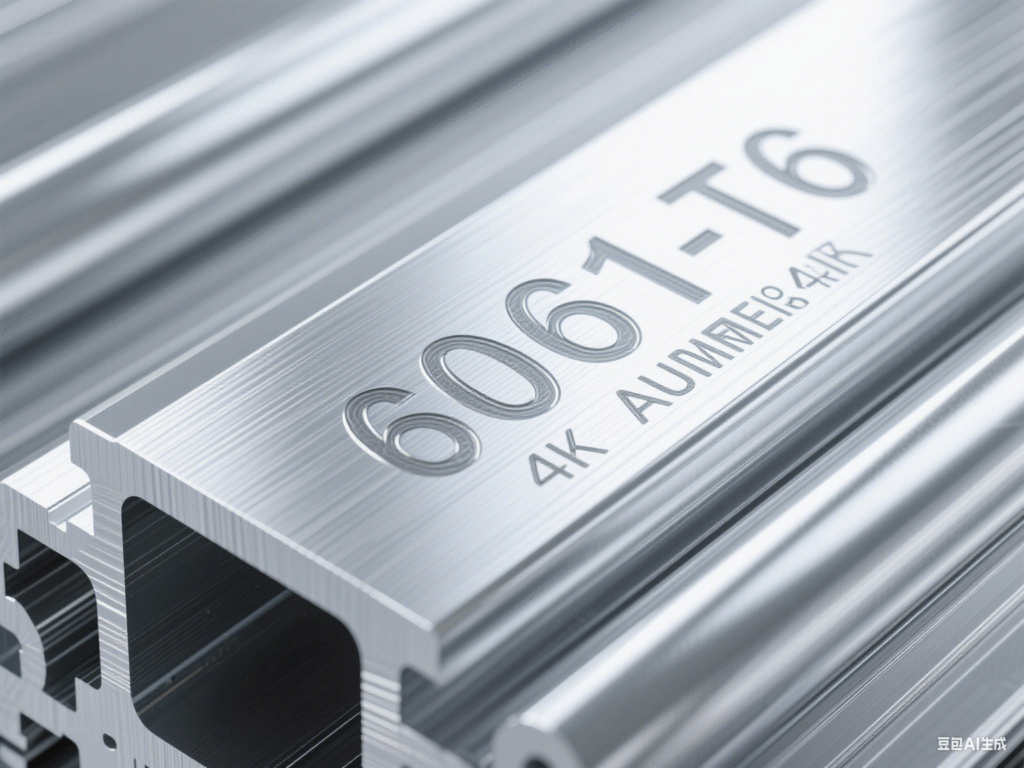
It contains magnesium and silicon alloys, has a tensile strength of 45,000 psi (ordinary 6063 has only 30,000 psi), has strong bending resistance, and will not deform under hurricane-level winds (110-130mph).
Avoidance points: Be wary of “recycled aluminum” (remelted with scrap aluminum), which has many impurities and uneven strength.
Use a magnet to detect (pure aluminum does not attract magnets, recycled aluminum may contain iron), or ask the merchant to provide a “material certificate” (U.S. standard MIL-A-8625F).
- Thickness: Main frame ≥ 2.5mm, 3.0mm for hurricane zone
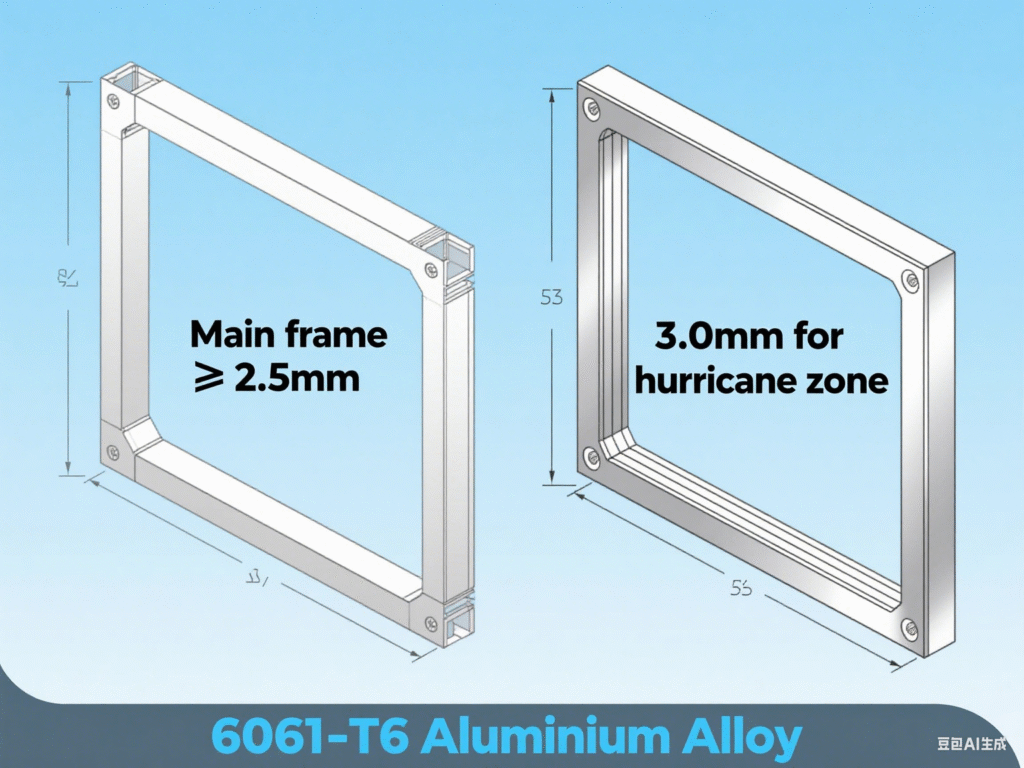
Thickness determines wind resistance, don’t believe the saying “thin and light is more advanced”:
Ordinary areas (such as the Northeast and West Coast non-hurricane areas): Main frame thickness ≥ 2.5mm (measured with a caliper, don’t calculate the coating thickness),
Hurricane zone (Florida, southern Texas): directly choose 3.0mm, which can withstand 130mph strong wind (equivalent to the wind force of Category 3 hurricane).
Our actual test in Florida: 2.0mm thick frame will bend slightly at 100mph wind speed, while 3.0mm thick is no problem at all (attached with a comparison chart of wind resistance test of two thicknesses).
- Surface treatment: Powder coating is a “sun-resistant necessity”
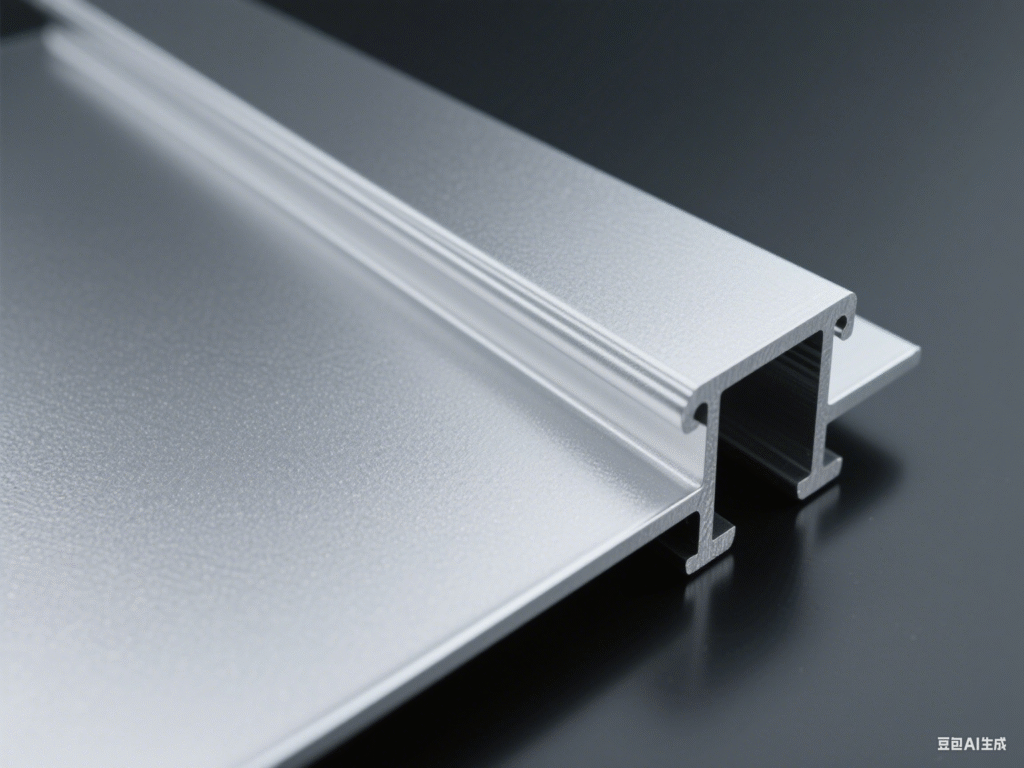
The sun in the United States is strong, especially in Arizona, New Mexico and other regions, where the UV index in summer often reaches 15+. Ordinary spray paint will crack, fade and peel after 3-5 years.
You must choose Powder coating spray: This is the “weather resistance standard” of the US construction industry, with a UV resistance level of UV 40+, which can guarantee no fading or powdering for 15 years.
How to verify?
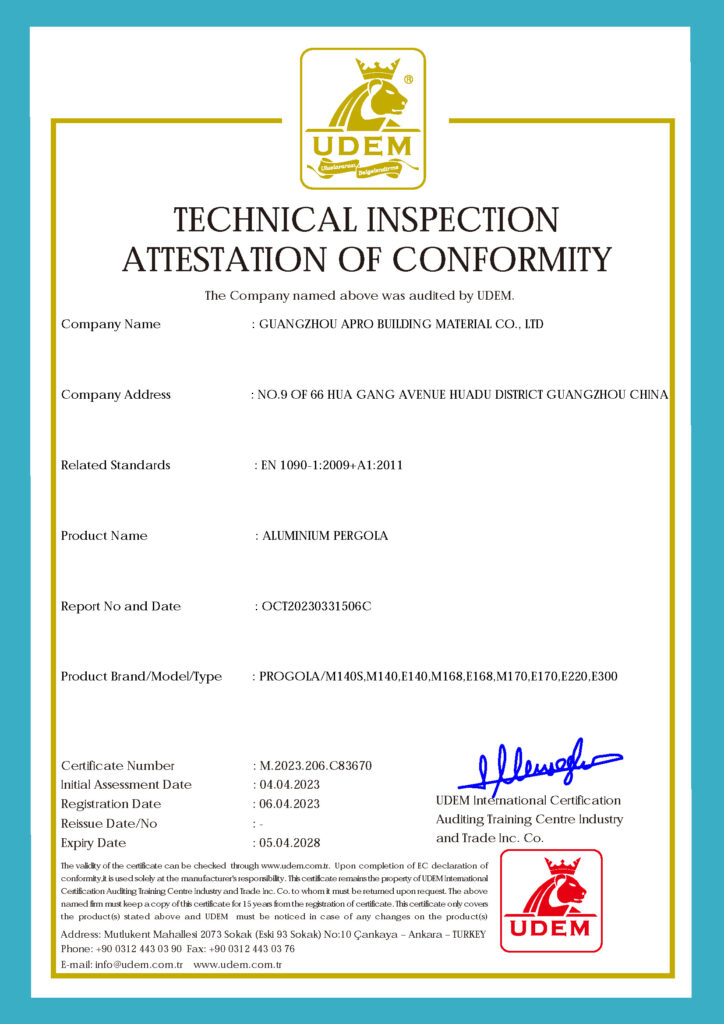
Ask the merchant to provide a “Powder coating report” (American brands such as PPG and Axalta have them), and avoid “imitation fluorocarbon paint” (half the price, but the weather resistance is much worse).
Why is this important?
The US HOA (Homeowners Association) has clear requirements for the “wind resistance” of outdoor structures, most of which stipulate “wind resistance level ≥ 110mph”.
If the material does not meet the standard, it will not pass the approval at best, and will be required to be demolished at worst (a community in Florida once forced the demolition of 12 “wind resistance-substandard” pergolas, and the owners lost an average of $5,000+).
2,Design adaptation: “zero incompatibility” with American villa style, faster HOA approval
There are too many American villa styles (Ranch, Colonial, Mediterranean, Modern). If the pergola design does not match the house, it will not only be ugly, but may also fail to pass HOA approval (many communities have strict regulations on the style and color of “visible structures on the exterior wall”).
- Ranch style (most common in the United States): simplicity is the “safe card”
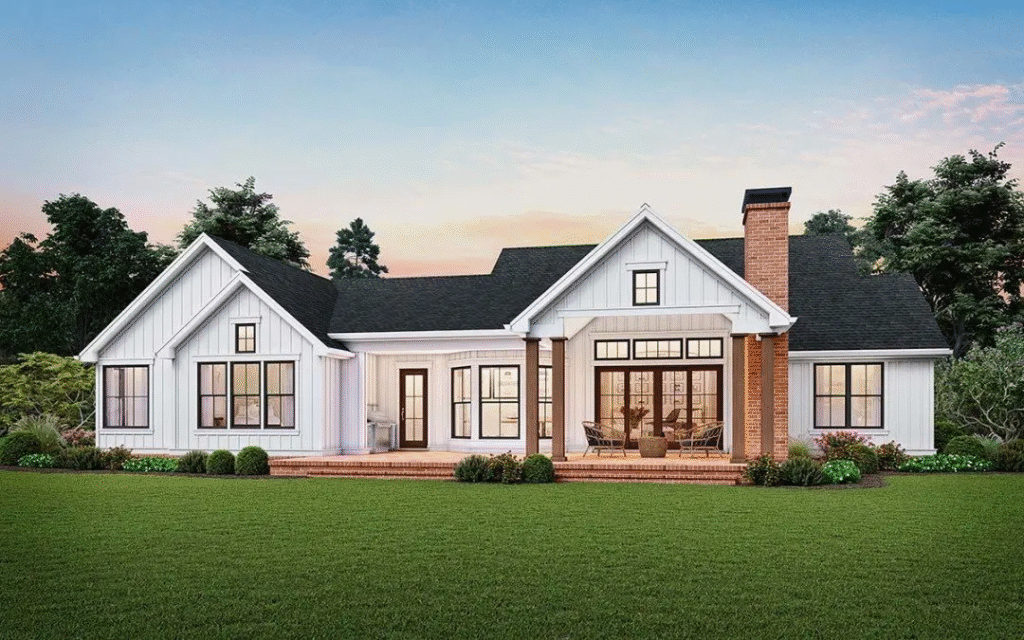
The characteristics of the Ranch style are “flat floors, sloping roofs, and exterior walls are mostly bricks or wooden boards”. The pergola design should be “low-key and not steal the show”:
Styling: Choose a flat roof + column-free design (visually lighter and does not block the view of the courtyard);
Color: Match Earth Tone (earth brown, sand, light gray), echoing the color of the exterior wall bricks;
Details: Avoid complex carvings or decorative parts (HOA may find it “too abrupt”), and use a “10cm wide simple style” for aluminum beams.
- Colonial style (symmetric, classical): Add “decorative columns” for more coordination
Colonial style houses are mostly “symmetrical structures, white exterior walls, black shutters”, and the pergola design should reflect the “classical feel”:
Shape: Choose a “slightly sloping roof” (slope ≤ 5°) to echo the roof line;
Columns: Use “pseudo-classical columns” (such as Doric simplified style), and the height should be flush with the bottom edge of the window;
Color: white or black (the same color as the doors and windows), avoid color (easy to destroy the symmetrical beauty).
- Mediterranean style (exotic style): curved roof + carved aluminum decoration
Houses in this style mostly have “red tile roofs, curved doors and windows, stucco exterior walls”, and the pergola can be more “distinctive”:
Shape: Choose a curved roof (echoing the curvature of the doors and windows);
Decoration: Aluminum beams plus “simplified European carvings” (don’t make it too complicated, otherwise the HOA may not approve it);
Color: dark brown, bronze (forming a warm contrast with the red tiles).
- HOA approval “bonus points”
Prepare “3 case studies of similar communities” in advance: Tell HOA “other communities do the same thing”, and the approval rate will increase by 60% (our California client used this trick to shorten the approval time from 45 days to 15 days);
Choose “options on the color card”: Many HOAs will provide “allowed color cards” and choose directly from them to avoid “custom colors” (longer approval process).
3,Functional design: 2 “bonus points” frequently used by American owners
American villa owners buy pergolas not only for “sunshade”, but more for “expanding outdoor space” (barbecue, meeting guests, afternoon tea). If the functional design is good, the usage rate can be increased by 3 times.
- Electric sunshades: Choose Sunbrella fabric, which is UV-resistant and mildew-resistant
Don’t use “manual roller blinds” (too troublesome, no one wants to climb a ladder every time to open and close), just use electric sunshades:
Fabric: Must be Sunbrella (the “gold standard” in the US market), 98% UV-resistant, no mold in the rain (a must-have in the humid southern regions), and a service life of 10 years or more (ordinary fabrics will rot in 3 years);
Control: Equipped with “remote control + wind and rain sensor” (automatically closes when it rains, no manual operation required), if the budget is sufficient, you can add “mobile phone APP control” (but don’t choose “voice control”, the US network stability is average and prone to failure).
- Hidden drainage: Make the slope according to the “American building standards”
The northern United States is rainy and the southern United States is prone to heavy rain. If the drainage is not done well, the pergola will become a “small pond”:
Slope: The top must be made into a slope of 1/4 inch/foot (that is, for every 1 foot of extension, the height drops by 0.25 inches) to ensure that rainwater flows to the drain;
Drain: Use a “4-inch diameter PVC pipe” to directly connect to the courtyard’s rainwater system (do not let the water drain directly on the lawn, which may cause mud);
Winter protection: In northern regions (such as New York and Chicago), add a “removable filter” to the drain to prevent clogging with fallen leaves (freezing in winter will burst the pipe).
4,Pitfall avoidance guide: Don’t spend 3 “wasted money” in the US market
The labor and maintenance costs in the United States are too high. When choosing a pergola, you must “spend money where it counts” and don’t pay for “flashy” functions.
- Don’t buy “imported products without UL certification”
The United States has strict safety standards for outdoor building materials, and pergolas must pass UL certification (testing wind resistance, fire resistance, and corrosion resistance).
Risk: Uncertified products (mostly low-priced imported goods) may not pass HOA approval, and may even pose safety hazards (aluminum beams of imported pergolas have broken under 30mph winds);
Verification: Require merchants to provide “UL 723 fire certification” and “ASTM E119 wind resistance test report”, both of which are indispensable.
- Don’t add “unnecessary smart functions”
Merchants may recommend “automatic temperature measurement, human body sensing, and music system”, but these functions are “too cost-effective” in the United States:
Difficult to repair: The on-site fee for American technical workers is at least $150 per time, and it is very troublesome to repair the smart module if it breaks;
Poor practicality: “Automatic temperature measurement” is not as practical as “wind and rain sensor”, and the sound quality of “music system” is not as good as buying an outdoor speaker separately (which is cheaper).
Suggestion: The basic model (remote control + wind and rain sensor) is sufficient, and the money saved can be spent on “thickening the material”.
- Don’t look for an “out-of-town installation team”
The installation of a pergola is a “technical job”, and it is especially important to be familiar with the local climate characteristics (e.g., snow load must be considered in the north, and typhoons must be prevented in the south):
The advantages of the local team: familiar with local building regulations (e.g., New York requires embedded parts to be 36 inches deep, while California requires 30 inches), and can provide “on-site service within 24 hours” (out-of-town teams may have to wait for 1 week or more);
How to judge local?
Require the team to provide “5 local cases in the past 6 months” and be able to conduct on-site inspections (avoid “sheep-headed dog meat” agents).
5,Installation acceptance: 2 “must-check items” of the US standard
If the installation is not in place, no matter how good the material is, it will be useless. There are two “life-and-death” details in the installation of American villa pergolas, which must be paid close attention to.
- Embedded parts: sufficient depth and bolts to be “rust-resistant”
Embedded parts are the “foundation” of the pergola, especially in hurricane zones, and must comply with the “American Concrete Institute (ACI) Standards”:
Depth: ≥30 inches in ordinary areas, ≥48 inches in hurricane zones (from the ground to the bottom of the concrete), measured with a tape measure (don’t listen to the merchant’s “deep enough”);
Bolts: must be hot-dip galvanized bolts (galvanized anchor bolts), diameter ≥½ inch, length ≥12 inches (to ensure full engagement with the concrete);
Concrete: strength ≥3000 psi (require the merchant to provide a concrete test report), avoid using “quick-drying cement” (not strong enough).
- Wind resistance test report: Only those issued by a third party can be trusted
Don’t believe the installation team saying “our installation is very solid”. A third-party test report is required:
Content: clearly mark the “wind resistance level” (such as 130mph) and the testing agency (a US-accredited laboratory, such as Intertek, UL);
Retention: Print 2 copies, one for HOA filing and one for your own storage (you may need to prove “outdoor structural compliance” when selling the house in the future).
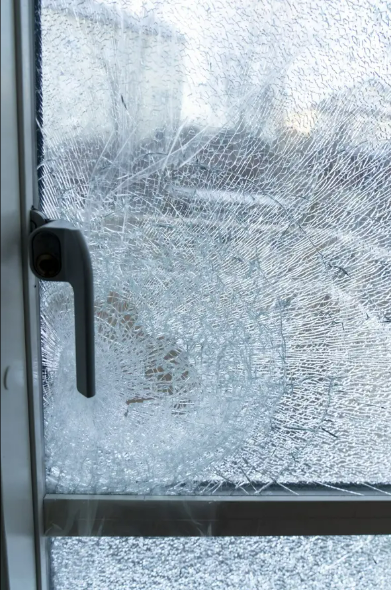
Case: “Hurricane-resistant pergola” renovation of a Florida coastal villa
Owner’s pain point: The original pergola was made of 2.0mm ordinary aluminum alloy. In 2022, Hurricane “Ian” (wind speed 125mph) caused the frame to deform and the glass to shatter.
HOA required “replacement to a style with wind resistance ≥130mph within 30 days”.
Solution:
Material: 6061-T6 aluminum alloy (3.0mm thick), Kynar 500 spray (anti-salt spray corrosion, suitable for the seaside);
Design: Ranch style adaptation (flat top + earth brown), 3 community similar cases were submitted to HOA, and approved in 3 days;
Installation: embedded parts are 48 inches deep, hot-dip galvanized bolts are used, and third-party testing shows wind resistance of 130mph.
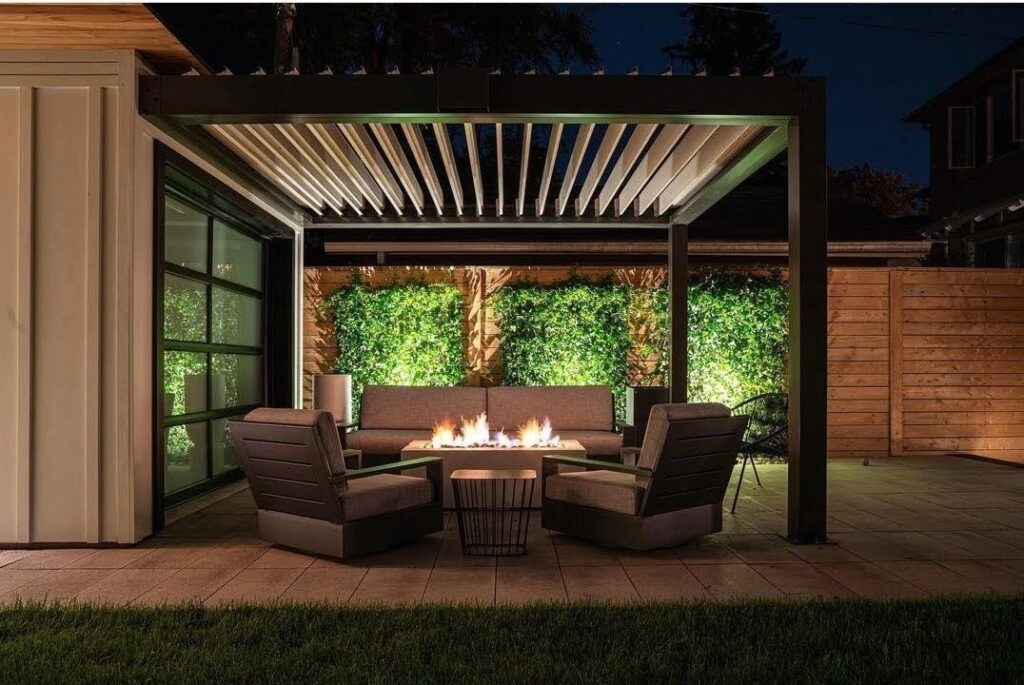
Effect: No damage after Hurricane Nicole in 2023 (wind speed 105mph), the owner reported that “the outdoor usage rate has increased from 1 time a week to 5 times, barbecue under the pergola in summer and drink tea in winter, it is worth the cost” (with a comparison of before and after the transformation).
Conclusión
The next step is to do this:
First check the “Outdoor Structure Code” of your HOA (attached with the link to the HOA query in each state in the United States: click to obtain), and focus on “wind resistance level, style restrictions, and color requirements”;
Choose the basic model according to “6061-T6 material + 2.5mm thickness” (directly 3.0mm in the hurricane zone), and don’t spend more money on “smart functions”;
When designing, refer to “case drawings of villas in the same style”, and attach “community similar cases” before submitting for approval, and the approval rate will be higher.
Need more specific “local cases”? Click here → “Villa Pergola Design Cases in 10 Major States in the United States”, including HOA approval templates, material test report samples, and free appointments with local American designers to measure on site (covering 10 states including California, Texas, Florida, etc.).
Which state is your home in? Leave a message to tell me, and I will give priority to sending you the wind resistance level standards and style cases of the corresponding area~

